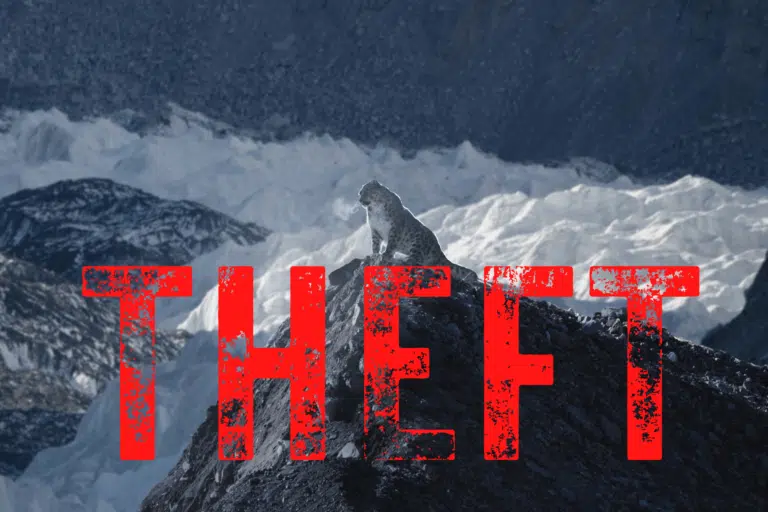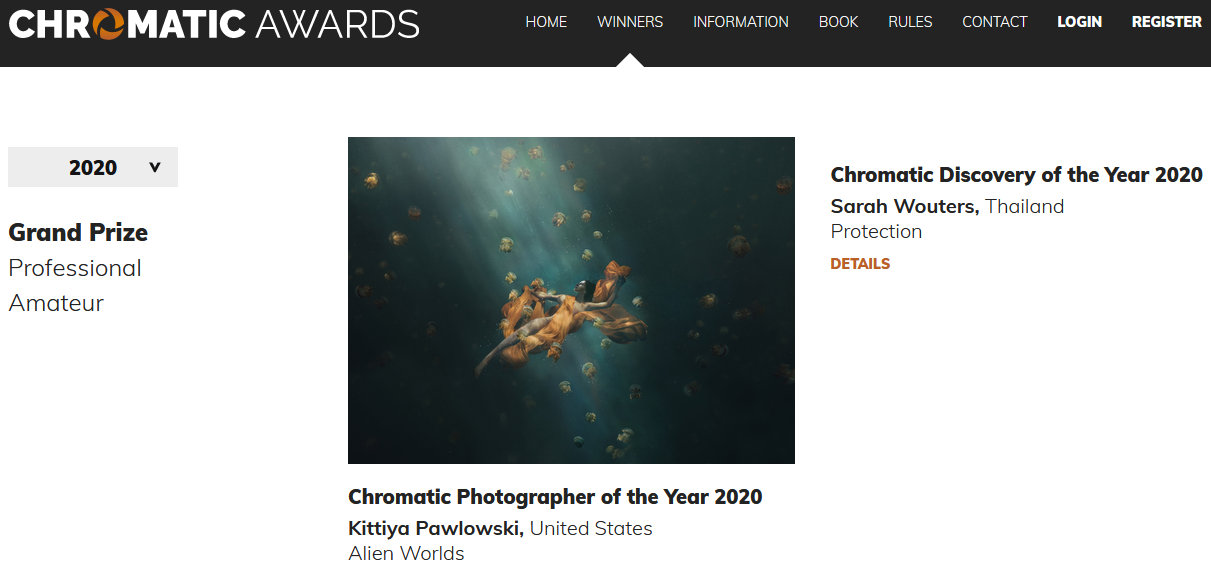The recent snow leopard hoax photo scandal by US photographer, Kittiya Pawlowski, is yet another example of how the allure of building a career by winning photo contests can corrupt a photographer.

What began as a viral wildlife photography story has uncovered a budding photographer who built a career partly on lies.
The greatest and fakest
A month ago Pawlowski was applauded for capturing a couple of the finest wildlife photos of the endangered snow leopard. Posed majestically in front of snow-capped Himalayan mountains, the photos are perfect. And to accompany them is a yarn spun by Pawlowski about how she ‘backpacked 103 miles’ and ‘straddled the top of the world’ in pursuit of the elusive snow leopard.
These photos found a massive global interest by following a well-trodden path, from the foothills of social media to the peaks of seemingly credible mainstream media.
After Pawlowski shared the photos to her social media channels, Reddit users began posting them to popular subreddit community pages, including r/photography.
News outlets in pursuit of feeding the hungry beast of the 24-hour news cycle monitor popular subreddits for anything to easily whip into readable content.
Pawlowski’s story was perfect for the content-hungry news machine – incredible photos backed up by a detailed blog post about the journey. This provides online reporters the ingredients to write a story without much legwork.
The ‘wildlife’ pictures were published by mainstream news outlets such as The Times London, Times Express, The Indian Express, and photo specialist media like Petapixel and Chasseur d’images, along with others.
A news outlet publishing a set of images gives them a stamp of credibility. A level of trustworthiness that can’t be gained through rampant sharing on social media, which is rife with bad information.
Only one media outlet – Alpine Magazine, a small independent French publication dedicated to mountaineering, began questioning the veracity of the photos and the photographer’s story. The photography websites which featured it simply didn’t twig.
The editorial team were disturbed by the lighting, which appears ‘a little strange and the images show collage effects reminiscent of photo montages’. And Pawlowski’s photography website is centred entirely around the snow leopard trip, despite an apparently decade-long career.
Alpine Magazine went above and beyond to investigate the photos. They conducted vigorous research to uncover multiple inconsistencies, surveyed meta data, spoke with snow leopard photographers about the animals’ behaviour, and studied Kittiya’s website.
Nothing added up. Journalists Jocelyn Chavy and Ulysse Lefebvre concluded:
– Three photos are demonstrably fake (collage of several fragments of photos);
– The photographer’s real identity remains in doubt;
– The leopard is shown in an improbable location, confirmed by snow-leopard specialist Vincent Munier.
Alpine Magazine‘s follow up found more holes in her story. One of her composites appropriates a snow leopard captured by French wildlife photographer, Sylvain Cordier, in Mongolia’s Altai Mountain. Pawlowski inverted Cordier’s snow leopard, but the shape and pose are identical.
‘She has played about a bit with the spots. She’s taken the underside of my leopard’s belly and put it on the leopard on the left…. In any case, seeing my photo next to hers, especially when I turn it, I’m 99.99 percent sure it’s mine.’
Pawlowski purports to have already profited from the photos. Before knowing they were investigating her images, she boasted to Alpine Magazine about selling almost 50 prints. At time of publication she had a snow leopard print for sale on the Saatchi Art marketplace for $2235 with the following description:
‘Straddling the top of the world, I backpacked 103 miles on foot in pursuit of one of the world’s most elusive animals—the snow leopard.
On a bitterly cold morning, I followed the icy rim of a gaping chasm, scoping out the Khumbu Valley with my Nikkor 500mm f/4 lens. After finding more snow leopard tracks outside Gorak Shep (16,942 ft / 5,164 meters), I was confident I would find something. At 18,000 feet (5486 meters) the weather was unpredictable. Within minutes one was alternatively freezing or roasting in the sunshine. This altitude is the limit of where snow leopards roam; however, to get the best view of the valley, I had to climb. Squinting through my camera’s telephoto lens, I noticed something in the shadow of Mount Pumori. At first, I thought it was a rock, but it was exactly what I was looking for.’
Who is Kittiya Pawlowski
This is one of the questions The Times London or Petapixel should have considered asking prior to publishing her fantastic snow leopard photos.
According to her website bio:
‘Kittiya Pawlowski is a photographer and digital artist that uses visual storytelling to capture the beauty of Earth. Her work focuses on enhancing communities while producing economic and social incentives for wildlife conservation, protection, and restoration.;
Her website only went live on July 18, 2022, according to Shotkit. Her previous website, Kittiyastudios, features heavily edited photo art. After her snow leopard composite was exposed, she added a disclaimer to the website:
‘To clarify, all my images are edited and processed in Photoshop and Lightroom. Some images are composites, some are not. Some are only lightly retouched. I am NOT a journalist. I never stated my images were not edited anywhere.
I have numerous awards for fine art and manipulation which you can see on my about page. This is what I have been doing for years.
News and media from around the world stole my images and published them with their own meaning. They did not ask me if they were edited. They interpreted them in their own way and spread them around the world. They told their followers that they were not edited. This is untrue, I always edit my images. I am a digital artist, sometimes I license images to create artwork.’
Pawlowski has a point. No media asked her about editing or wildlife photography prior to running the pictures, and her earlier work is heavy on photo manipulation. It’s essentially graphic art.
A leopard can’t change its spots
It’s hardly surprised to discover the photographer’s professional credibility hinges almost entirely off a long list of photo contest accolades. The majority of which are shady for-profit organisations which you would not put in the front of the queue for integrity and transparency.
Pawlowski won the 2020 Chromatic Awards grand prize and scored two category wins; and received honourable mention or was a finalist in the 2021 Neutral Density Awards, 2021 Fine Art Photography Awards, and Annual Photography Awards.

These four contests are linked to a colourful Polish-born London-based photographer, Martin Stavars, also known as Sebastian Stavars. Inside Imaging has covered this individual’s photo contest empire several times, most recently after two judges found the judging process extremely dubious and had no idea how a winner was selected. In previous years, Stavars was accused of falsely listing photographers as judges.
The accusations are levied against different photo contests to those won by Pawlowski. But it’s clear Stavars contests are built to turn a profit, and the spirit of running a quality photo contest isn’t there.
She has also won awards from contests in the Farmani Group stable, which in a previous article we have noted: ‘runs more international awards in more countries than any other’.
The mysterious Pawlowski has won accolades via three sets of images. One is a silhouette of men riding elephants next to a tree in Thailand; another is a surreal underwater photo showing a model surrounded by Jellyfish in Indonesia; and the last a model holding flowers submerged in a lily pond.
Alpine Magazine revealed the elephant photo is not hers. It’s a stock photo, available via Shutterstock Thailand since 2017. Yep – stolen. Or licensed, maybe. Either way, Pawlowski has no business entering it into contests as her own.
No evidence yet suggests the two other images feature elements that come from a third-party or are stolen, but the heavy editing style should have prompted media outlets to look closer at the snow leopard pictures.
The snow leopard photos never made it to the photo contest circuit. They’d have undoubtedly performed extremely well.
Traces of Saad
When disgraced Melbourne commercial photographer, Lisa Saad, was accused of appropriating photographic elements by Dutch architectural photographer, Marcel van Balken, she responded aggressively.
At the time Saad asked Inside Imaging to hold off publishing anything as the ‘matter is with my lawyers’, who sent legal threats to Photo Stealers’ Corey Balazowich, requesting she remove an article exposing Saad, apologise and provide compensation.
Pawlowski is, likewise, defending herself by launching an attack. Alpine Magazine claims she requested Google to de-list them from search results relating to snow leopards, and has filed DMCA takedown notices over the leopard picture.
When caught red-handed, it’s a bold move to double-down and claim innocence. Perhaps it’s a last ditch survival effort by someone with a proclivity for dishonesty.
With both Pawlowski and Saad there seems to be an almost unanimous opinion that they deceived the public for personal gain. Whether that be from media exposure or contest wins.
Yet there are only a few degrees of separation between their actions – which the consensus rightly judges as wrong – and photo manipulations that are embraced and awarded. It’s okay to push landscapes beyond reality, but a wildlife composite or using non-photographic elements is a bridge too far.
Many photographers are equipped with similar skills but restrain themselves from venturing down a similar path. Perhaps they have a sharper understanding of the difference between right and wrong. Perhaps the ignominy of being exposed is preventative enough. Although it’s concerning to consider how many others could easily be getting away with it.





“but a wildlife composite or using non-photographic elements is a bridge too far.”
There’s nothing wrong with that. The ‘bridge too far’ is posting the image online and pairing it with a story that makes it sound like the user went on a journey and captured the image, presumably close to as-is. It would have been fine if the user’s website was called Fantasy Wildlife Concept Art dot com, but it’s not.
Anyone who looks at the vast amount of astrophotography and Northern Lights photography out there can see there are a number of photographers with “skills” like Pawlowski who CAN’T restrain themselves. Composites are rampant — it’s common to combine a foreground image and a background star image with different exposures. But being honest about it, both for photographers and the contests/publications that present the images, is the key. On the whole, dishonesty around these images undermines viewers’ ability to determine what is real anymore.
Just like the many Social Media posts by individuals who live out a fantasy life by making stuff up, it’s not surprising that there are also photographers with a certain level of psychological dysfunction that choose the path of deception to create a fantasy world of fame and adulation. It’s disturbing to see how the basic tenets of honesty and integrity are being eroded within society and misrepresentations are seemingly blossoming, thanks to the ability of people to scan the internet to gain access to resources that they can manipulate to gain fame. I applaud Corey Balazowich, who sees a lie and calls it out, so that we can maintain the integrity of honest creative works. Imagine a world where anything goes, because no one is prepared to check and verify. With the AI phenomenon about to embed itself into all aspects of everyday life, I fear that we will only see more people seizing the opportunity to misrepresent and deceive using non-original creative works. The levels of hacks, spam and online fraud show that this trend isn’t going to stop any day soon. We encourage critical thinking in our children’s development. Same goes for so many adults who don’t view what they see and read as worthy of further investigation.